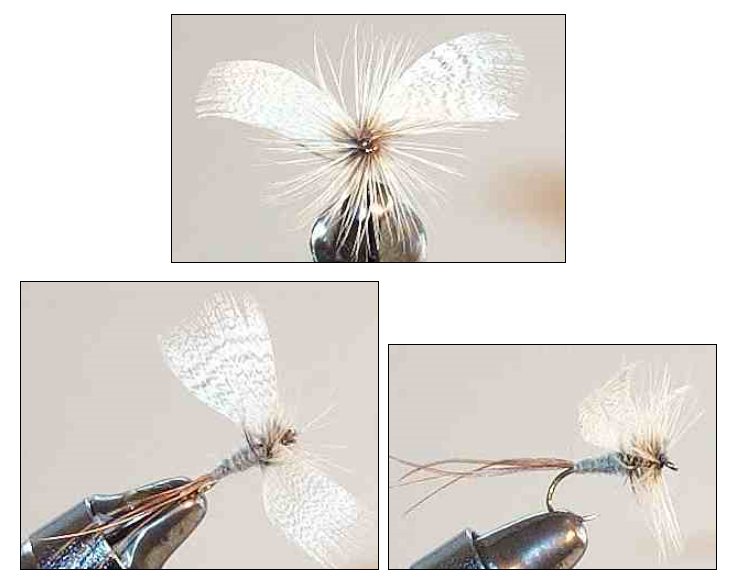The Blue Dun Mayfly Spinner
The Blue Dun Mayfly Spinner fan-wing dry fly pattern imitates the final stage in the Mayflies life cycle. Many of these insects fall to the waters surface to lay eggs or just exhausted from mating. This is when they are taken by lurking trout and graying.

FANWING MAYFLY BLUE DUN SPINNER DRY FLY. Hook size 12 16 - $US each
The Blue Dun Mayfly Spinner dry fly achieves deception not only because it looks something like the real thing, but also because it behaves so naturally, alighting gently onto the water like an egg laying spinner or a dun mayfly needing a second attempt to take off. Some anglers try this fly and hate it. They are casting it wrong. It is important to cast gently and that means not covering too much water with each cast. This pattern is deadly provided the hatch is on but not so profuse that the trout are too spoil for choice.
The spinners gather together over the water in swarms where they mate, lay eggs and fall back to the water surface spent. They have no energy left so they float on the surface film with their wings horizontal and flattened. A mayfly dun hatch can occur over a number of weeks but a mayfly sinner swarm, mating and fall often happens all at once within a one hour period. It can result in a feeding frenzy where the water boils with the activity of munching trout. Compared with mayfly duns, spinners have long tails and, slim bodies and larger translucent wings. Fish them dead drift over the feeding zone. Make sure your presentation is drag free otherwise you will scare away your target trout. The spinners are either dead or dying. Your fly should not move other than being slowly drifted downstream, caught in the water surface film. Any unnatural movement will spook the fish.
The best way to imitate a spinner after you have cast the fly on the water is to do absolutely nothing. You are trying to imitate a dead insect and as you realise dead insects don't move. I like to stand upstream from my target fish and let the fly float down towards them. This way it reduces the amount of leader the trout can see.
The Pale Morning Dun
It is hard to pick the exact dates of a PMD hatch start and finish as there are many local factors that will cause them to change from year to year. These can range from the prevalent weather conditions and water temperature to what happened during last year’s winter, if it was mild or harsh. This is not too much of a problem with this species of upwinged fly as the hatching season can lasts weeks or even months unlike some other mayflies. You just have to be prepared. Make sure your tackle box is kitted out with different Pale Morning Dun fly patterns to match all contingencies. If you hear of the PMD hatch starting on your local river or lake do not be tempted to drop everything and drive down to the water. I like to wait a week. That way I know the trout will be keyed into eating this new food source. When the water temperature is correct they will be waiting for them to rise to the surface and start emerging. In clear chalk stream water have witnessed trout taking their feeding positions a few hours before the hatch so that they have the best spot.
Pale Morning Duns peak hatching period occurs when the water temperature is between 55°F and 60°F. Some more hardy PMD’s will emerge when the water is in the low 50soF’s so keep your eyes open for the tell tail disturbances on the water surface. A floating thermometer can be a useful bit of kit. Water temperatures will be effected by altitude, presence of springs, dams or the runoff from nearby melting snow.
I have found that emergence of pale morning dun adults occurs from 11am until 4pm. They are not normally an early morning or late evening rise species. The exception to the rule is if there is a heat wave. You can then expect hatches to occur in the early morning or late evening when the temperatures have cooled. I have found that when you are near the end of the PMD hatch season there are fewer adult flies emerging. The window of activity decreases from up to four hours down to one.
Here is a rough guide to PMD hatches in North America. Before you travel phone local guides or tackle shops for a situation report. Remember what I said about waiting a week from the start of the hatch. Please e-mail me with any additions or corrections. craig.moore@blueyonder.co.uk
Alberta: Bow River, Crowsnest River June 15th – July 15th.
British Columbia: Elk River June 15th – July 15th.
California: Fall River May 15th – August 31st; Hat Creek May 20th – August 15th; Pitt River May 20th – August 31st.
Colorado: Arkansas River Colorado River, Frying Pan River, Gunnison River, Platte River June 15th – September 15th; Delores River July 1st – August 15th.
Idaho: Henry’s Fork of Snake River June 15th – June 30th and July 15th – August 31st; Silver Creek may 15th –August 15th; South fork of Snake River below the Palisades Dam July 1st – October 31st.
Montana: Bighorn River below the Yellowtail dam July 15th - August 31st; Madison River July 1st – August 31st; Missouri River below the Holter Dam June 15th – August 31st; Yellowstone River July 5th – August 15th.
Oregon: Deschutes River below the Pelton dam June 15th – August 15th; Metolius River, McKenzie River my 15th – August 15th.
Utah: Green River May 25th July 31st; Provo River below Deer Creek Reservoir May 15th – June 30TH.
Washington State; Yakima River May 15th July 15th.


Fly Fishing books

